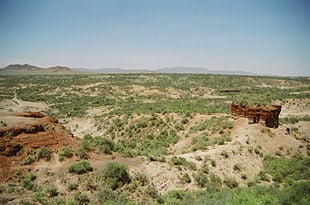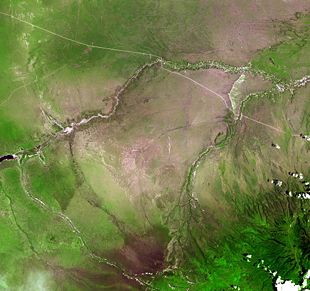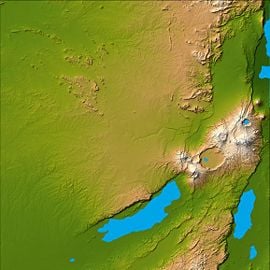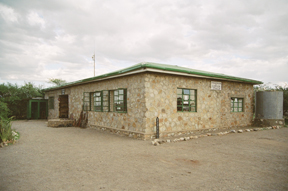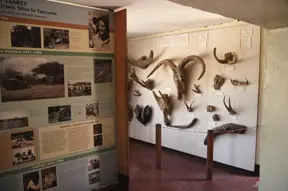Olduvai Gorge
Olduvai Gorge or Oldupai Gorge is located at the border of the Ngorongoro conservation area and the Serengeti National Park in Tanzania. This world famous paleoanthropological site was studied for more than 40 years by the Louis Leakey and his family. The 40 kilometer-long ravine yielded numerous fossil remains from pliocene to pleistocene times (from about five million to 10.000 years ago), including the skull of the primitive hominid australopithecus boisei or "nutcracker man," and homo habilis "human who use tools." The site has also produced remains of stone tools, animal bones, and other early hominid remains. The fossilised footprints, found by Mary Leakey at nearby Laetoli, showing prehuman hominids walking in a upright position is one of the greatest paleoanthropogical discoveries of the twentieth century. Based on findings at Olduvai Gorge, and other findings in Tanzania, scientists concluded that anatomically modern humans made their first appearance in East Africa.
Description
The Olduvai Gorge or Oldupai Gorge is commonly referred to as the "Cradle of Mankind." It is a steep-sided ravine in the Great Rift Valley, which stretches along eastern Africa. Olduvai is in the eastern Serengeti Plains in northern Tanzania and is about 30 miles long. The gorge is named after the Maasai word for the wild sisal plant Sansevieria ehrenbergii, commonly called Oldupaai.
The gorge is one of the most important prehistoric sites in the world and has been instrumental in furthering understanding of early human development. Excavation work there was pioneered by Louis Leakey in the 1950s and was continued by his family. Some believe that millions of years ago, the site was that of a large lake, the shores of which were covered with successive deposits of volcanic ash. Around 500,000 years ago seismic activity diverted a nearby stream which began to cut down into the sediments, revealing seven main layers in the walls of the gorge.
The stratigraphy is extremely deep and layers of volcanic ashes and stones allow radiometric dating of the embedded artifacts, mostly through potassium-argon dating.
Findings
The main Olduvai Beds are in a lake basin about 16 miles in diameter. The rocks under the basin date to 5.3 million years ago. The first artifacts in Olduvai (pebble tools and choppers) date to approximately 2 million years ago but fossil remains of human ancestors have been found from as long as 2.5 million years ago. The Olduvai Gorge bears the distinction of having the oldest known evidence of mammoth consumption, attributed to Homo erectus around 1.8 million years ago.
Exposed deposits show rich fossil fauna, many hominid remains and items belonging to the one of the oldest stone tool technologies, called Olduwan.
Seven major Beds have been distinguished, ranked from oldest to youngest: Bed I, Bed II, Bed III, Bed IV, the "Masek Beds," the "Ndutu Beds," and "Baisiusiu Beds."
Bed I dates to 2,100,000 years old and is 197 feet thick. It is mainly formed of lava flows, volcanic-ash deposits and other sediments. The upper part of the bed contains varied fauna and evidence of the Olduwan industry.
This Bed has produced evidence of campsites and living floors along with flint tools made on flakes. Bones from this layer are not of modern humans but primitive hominid forms of Australopithecus boisei and the first discovered specimens of Homo habilis. The debris found at the sites are various Olduwan tools, bone, and teeth from animals, mainly from fair sized antelopes. Also a loosely built circle of lava blocks was found, suggesting the formation of crude shelters.
Above this, in Bed II, pebble tools begin to be replaced by more sophisticated handaxes of the Abbevillian industry, and made by Homo erectus. This layer dates to around 1.5 million years ago.
Bed II is 66-98 feet thick and is 1,150,000 to 1,700,000 years old. It has two main divisions of rock layer, upper and lower, that were separated by an erosional break. The lower part of Bed II is similar to Bed I. The upper part was formed after fault shifts had reduced the ancient lakes size. It is in this part of Bed II that the development of the Acheulian industry starts to show. Here also are the remains of Homo Habilis, Homo Erectus and Australopithecus Boisei.
The gorge was modified by fault shifting and erosion. It is after these geographical changes that Beds III and IV were created. These two Beds range from 1,150,00 to 600,000 years ago.
Beds III and IV have produced Acheulean tools and fossil bones with Neanderthal characteristics which were used until around 600,000 years ago.
Beds above these contained tools from a Kenya-Capsian industry made by modern humans and are termed the "Masek Beds" (600,000 to 400,000 years ago), the "Ndutu Beds" (400,000 to 32,000 years ago), and the "Naisiusiu Beds" (22,000 to 15,000 years ago).
During a period of major faulting and volcanism roughly 400,000 to 600,000 years ago, the "Masek Beds" accumulated. There is only one major archaeological site found in these beds and it is of the Acheulian tool industry.
The "Ndutu Beds" were formed by faulting, erosion, and the filling of the gorge around 32,000 years ago. In this Bed, two sites have been found which date to the Middle Stone Age.
The last of the archaeological Beds is the "Naisiusiu." It lays in the bottom of the Gorge at what is now the present depth. It contains one site that has microlithic tools and one complete Homo Sapiens skeleton, both of which date to 17,000 years ago.
Also located on the rim of the Gorge is the Olduvai Gorge Museum, which presents exhibitions pertaining to the Gorge's history.
Museum
The Olduvai Gorge Museum is located in the Ngorongoro Conservation Area in Northern Tanzania on the edge the of Olduvai Gorge; directly where the Gorge split into two. It is approximately 5 km from the main road to the Serengeti plains, north west of the Ngorongoro Conservation Area.
The museum was founded by Mary Leakey in the late 1970s, and was originally designed to house paleoanthropological artifacts from the surrounding area. After her death, the museum was put under control of the Tanzanian Government's Department of Cultural Antiquities. During the mid-1990s The J. Paul Getty Museum's Department of Conservation renovated and added to the museum. This included a new wing with exhibitions that were designed by the J. Paul Getty Museum.
The exhibits at the museum are centered around the paleoanthropological research and artifacts that have come from the surrounding area. There is one hall dedicated to the Leakey family and their work at Olduvai Gorge. This hall has historical artifacts from the Olduvai Gorge area, as well as charts and maps explaining the process of fossil excavation. Many of the artifacts are original but some are casts (specifically the hominid skulls). The adjacent hall is dedicated solely to the Laetoli fossilized footprints. A cast that was made of part of the footprint trail in 1996 by the J. Paul Getty Museum is on display. Accompanying this are several charts and photographs describing and illustrating the process of the Laetoli Footprints creation. There is also a large illustration depicting three Australopithecus afarensis walking through the area 3.6 million years ago.
In addition to these indoor museum exhibits there are also two outdoor lecture areas, which are utilized for an orientation presentation given by museum staff. The staff mainly consists of people from the local Maasai tribe, and are housed in what was once the Leakeys' camp.
ReferencesISBN links support NWE through referral fees
- Pickering, R. 1968. Ngorongoro’s Geological History.
- L.S.B. Leakey, Adams Ancestors, The Evolution of Man and His Culture (Harper & Row Publishers 1960).
- L.S.B. Leakey, By the Evidence, Memoirs 1932-1951 (Harcourt Brace Jovanovich, Inc. 1974).
- Richard E. Leakey & Roger Lewin, ORIGINS (E.P. Dutton 1977) ISBN 0-525-17194-0.
External links
Credits
New World Encyclopedia writers and editors rewrote and completed the Wikipedia article in accordance with New World Encyclopedia standards. This article abides by terms of the Creative Commons CC-by-sa 3.0 License (CC-by-sa), which may be used and disseminated with proper attribution. Credit is due under the terms of this license that can reference both the New World Encyclopedia contributors and the selfless volunteer contributors of the Wikimedia Foundation. To cite this article click here for a list of acceptable citing formats.The history of earlier contributions by wikipedians is accessible to researchers here:
The history of this article since it was imported to New World Encyclopedia:
Note: Some restrictions may apply to use of individual images which are separately licensed.
